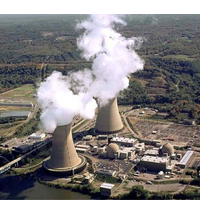Chesapeake Energy Gains Permission to Frack One Mile from Nuclear Power Station
 Beaver Valley Nuclear Power Station
Beaver Valley Nuclear Power Station
The state of Pennsylvania, which sits atop a portion of The Marcellus Shale and its bounty of natural gas, is experiencing an energy drilling boom reminiscent of its 1860s oil rush, which was the first in U.S. history. The keystone state has seen more than 3,000 natural gas “fracking” wells drilled in the past two years, with another 2,000 approved for permits.
Early in October, the state issued a permit to energy giant Chesapeake Energy, allowing it to conduct fracking operations near the small town of Shippingport (pop.: 237), one mile from the Beaver Valley Nuclear Power Station. In fracking, energy companies use powerful pumps to force pressurized fluid into deep layers of rock, causing fractures, which allow the extraction of otherwise unavailable natural gas.
On its face, fracking so close to a nuclear power plant seems like a bad idea, especially in light of a report released in March by the Ohio Department of Natural Resources concluding that a rash of 12 earthquakes in the Youngstown, Ohio, area between March and December 2011 was likely due to nearby fracking operations. Shippingport is less than 45 miles away from Youngstown, with similar geology. As AllGov has reported, earthquakes have been tied to fracking in other locales as well, including Arkansas, Oklahoma, Texas, British Columbia, Lancashire (UK) and others.
As the March 2011 Fukushima Daiichi nuclear disaster showed, earthquakes and other phenomena associated with them pose special risks to nuclear reactors. In fact, the Nuclear Regulatory Commission (NRC) warned in February that, “Nuclear reactors in the central and eastern U.S. face previously unrecognized threats from big earthquakes and it needs to require nuclear-plant operators to conduct new seismic studies for all 96 reactors in eastern and central states to determine if the plants could withstand the shaking predicted by the government’s new seismic model.”
Nevertheless, the NRC does not regulate any activities, including wastewater injection wells, oil and gas drilling, fracking, or any others close to nuclear power plants. As for the state, Pennsylvania Department of Environmental Protection spokesperson John Poister has admitted that there are no state regulations requiring a minimum distance between fracking and nuclear facilities beyond a blanket regulation mandating a 500-foot setback from any building to an unconventional well.
-Matt Bewig
To Learn More:
Fracking Fukushima Batman—Is that a Natural Gas Well Near a Nuclear Power Plant? (by Eric McGinniss, EcoWatch)
Ohio Government Confirms Earthquakes Caused by Fracking-Related Injection Wells (by Matt Bewig, AllGov)
Fracking Industry Fights Federal Regulation, Preferring Less Well-Funded States (by Noel Brinkerhoff, AllGov)
The Mysterious Journey of One $1.5 Million Campaign Donation to Pennsylvania’s Governor (by Noel Brinkerhoff, AllGov)
- Top Stories
- Unusual News
- Where is the Money Going?
- Controversies
- U.S. and the World
- Appointments and Resignations
- Latest News
- Trump to Stop Deportations If…
- Trump Denounces World Series
- What If China Invaded the United States?
- Donald Trump Has a Mental Health Problem and It Has a Name
- Trump Goes on Renaming Frenzy






Comments